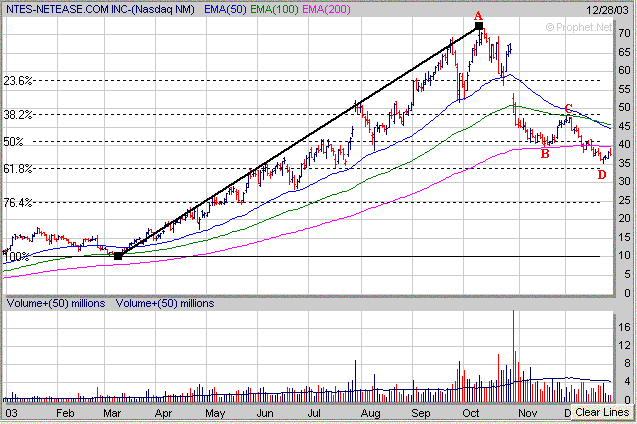|
Shorting Strategy
Shorting a stock is the exact opposite of buying a stock.
When you short a stock you are hedging your bets that the stock will go down in
price unlike when you buy a stock and believe the price will go up. In
order to short a stock you must have a margin account with your brokerage
firm. In addition you also have to short individual stocks on an up tick
but can short the Exchange Traded Funds (ETF's) on a down tick. Thus as an
investor you have more of an advantage shorting the ETF's than individual
stocks.
Many investors try and short a stock way to early as they
believe the stock price is way overvalued. However many times a stock that
is overvalued in price may become even more overvalued especially when the stock
market is in an extended upward move. The proper time to short a stock is
after it has encountered its first strong downward thrust and bounced for a
short period of time which sets the
stage for a second move to the downside.
Lets look at an example. NTES which made a huge move in
2003 eventually peaked in October of 2003 and then made its first strong
downward thrust (points A to B). Notice how NTES then found support
near its 200 Day EMA (purple line) and 50% Retracement Level near the $40
level. After finding support near the $40 level NTES then rallied on below
normal volume but encountered resistance at its 100 Day EMA (green line) and
38.2% Retracement Level near $48 (point C). This set the stage for a
second short opportunity as NTES began to stall out near the $48
level. In this example NTES could have been shorted around the $48
level with a Stop Loss Order placed just above the $50 level just in case NTES
broke to the upside instead. During the month of December NTES fell from
$48 to $35 a share but did find support just above its 61.8% Retracement Level
which was near $34 (point D). Thus investors could have covered
their short positions at one of two prices with the first at the 200 Day EMA
near $40 and the second near the 61.8% Retracement around the $34.

Thus I believe the best time to short a stock is to wait for it to bounce
after it makes its first major thrust downward, after going through an extended
upward move, and then try and catch the second move downward. When looking for stocks to short make sure they are
exhibiting these three characteristics.
1. The stock has already undergone one significant move
downward after making a top.
2. The stock then finds support at a certain Fibonacci Retracement Level
or Moving Average and rallies on poor volume.
3. The stock then stalls out near its 38.2%, 50% or 61.8% Fibonacci
Retracement Level or Moving Average after rallying.
By following these simple rules investors will have a much
higher success rate when attempting to short stocks.
Click here to signup for a
"Free" Two Week Trial Membership and see which Stocks will provide the
best Investment Opportunities in 2004
Other
Helpful Investing Articles
|



